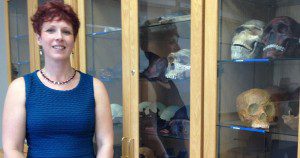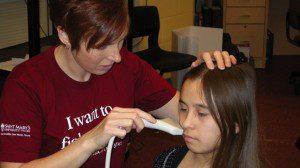Trina Roache
APTN National News
HALIFAX – A forensic scientist has added Mi’kmaw faces to the repertoire for identifying missing people.
Dr. Tanya Peckmann, an associate professor at Saint Mary’s University, has created a database for forensic artists to recreate Mi’kmaw faces. Her research was published in January in The Journal of Forensic Sciences.
As a forensic anthropologist, Peckmann gets called out when a body is found in Nova Scotia. Her job is to study the remains and determine age, gender and ancestry. The forensic artist creates a model of what the person looked like in life and all that information is plugged into a missing persons database.
But even if the person’s skeletal features indicated Aboriginal ancestry, the artist has had to rely on data for European facial features.
And Mi’kmaw faces look different.
“It’s not good enough to just put the white, European tissue depth data on them,” said Peckmann. “They’re still First Nations people and that is really important that their faces look different and so we want to be able to take this project across Canada. We want to include different populations in the data. Because it’s wonderful that the Mi’kmaw people now have this data for them but other population deserve that as well.”

Peckmann took a portable ultrasound machine to the Eskasoni First Nation in Cape Breton studied the tissue depth of 392 Mi’kmaw children and 152 adults between the ages of three to 75.
“If you think about your own face, the tissue on your cheeks is thicker than the tissue on your chin and that’s thicker than on your forehead,” said Peckmann. “So you need to know proportions on your face. But those tissue depths also vary between males and females, between people of different ages. And also between people of different ancestries.”
Mi’kmaw faces typically have deeper tissue depth around their cheeks and chin.

An example of why it’s so important can be found in the case of Donna Joe, a Mi’kmaw woman from the Esgenoopetitj First Nation in New Brunswick. Her body was found in 1996, and an RCMP forensic artist used European data to reconstruct her face. And it didn’t look anything like her. The cheeks were too gaunt, the chin didn’t match. A tip 10 years later changed everything.
“So the reconstruction artist said, you describe her, and he drew a sketch of what she looked like, they released that sketch and she was identified in 24 hours,” said Peckmann.
With 1,200 missing and murdered Indigenous women across Canada over the last 30 years, Peckmann says it’s vital to have the right information to be able to accurately identify those women and give them a face.
“I mean think about these families who’ve lost a mother, a daughter or sister,” said Peckmann. “Think of the anguish of 10 years of not knowing, for 20 years? Or even 10 days? Think about what they’re going through. So this is going to improve mental health situation in Aboriginal communities. I mean 500 missing Aboriginal women. That’s 500-plus family members. It’s not just the mother, sister or brother that’s suffering it’s an entire extended family because these people are missing.”

Peckmann would like to extend the project to other parts of Canada. The data that helps recreate Mi’kmaw faces doesn’t fit with Cree or Dene people. But funding is a major obstacle. Peckmann had trouble coming up with the money for the research she’s already finished.
Peckmann was disturbed by comments she received back in one of her grant applications.
“One of the reviewers was very critical of the project,” said Peckmann. “His or her comment was, how many Aboriginal women are missing? How many times are you actually going to use this data? And I thought, even if you only use it once, that’s still somebody’s family member. Isn’t that important?”









